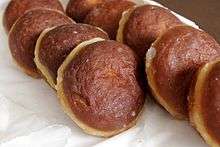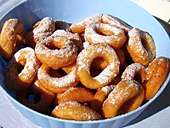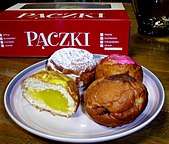Pączki
 Pączki with characteristic white stripes and collapses | |
| Type | Pastry |
|---|---|
| Place of origin | Poland |
| Main ingredients | Yeast-based dough, grain alcohol, confiture or other sweet filling, powdered sugar, icing, glaze or bits of dried orange zest |
Pączki (Polish: [ˈpɔntʂkʲi] (![]()
Description
Pączki are deep-fried pieces of dough shaped into flattened spheres and filled with confiture or other sweet filling. Pączki are usually covered with powdered sugar, icing, glaze or bits of dried orange zest. A small amount of grain alcohol (traditionally, Spiritus) is added to the dough before cooking; as it evaporates, it prevents the absorption of oil deep into the dough.[1] The common opinion is that the ideal pączek is fluffy and at the same time a bit collapsed, with a bright stripe around – it is supposed to guarantee that the dough was fried in fresh oil.[2][3]
Although they look like German berliners, North American bismarcks or jelly doughnuts, pączki are made from especially rich dough containing eggs, fats, sugar, yeast and sometimes milk. They feature a variety of fruit and creme fillings and can be glazed, or covered with granulated or powdered sugar. Powidła (stewed plum jam) and wild rose hip jam[1][4] are traditional fillings, but many others are used as well, including strawberry, Bavarian cream, blueberry, custard, raspberry, and apple.[5]
Pączki have been known in Poland at least since the Middle Ages. Jędrzej Kitowicz has described that during the reign of August III, under the influence of French cooks who came to Poland, pączki dough was improved, so that pączki became lighter, spongier, and more resilient.
- Pączki displayed for sale
 Traditional pączki serowe or oponki
Traditional pączki serowe or oponki Home-made glazed pączki
Home-made glazed pączki Assorted pączki commercially produced near Detroit
Assorted pączki commercially produced near Detroit
Etymology, spelling and pronunciation
The Polish word pączek [ˈpɔntʂɛk] (plural: pączki [ˈpɔntʂkʲi]) is a diminutive of the Polish word pąk [ˈpɔŋk] "bud".[6] The latter derives from Proto-Slavic *pǫkъ, which may have referred to anything that is round, bulging and about to burst (compare Proto-Slavic *pǫkti "to swell, burst"), possibly of ultimately onomatopoeic origin.[7][8] From Polish the word has been borrowed into several other Slavic languages, where the respective loanwords (ponchik[lower-alpha 1], ponchyk[lower-alpha 2] or ponichka[lower-alpha 3]) refer to a similar ball-shaped pastry.[9][10][11]
English speakers typically use the plural form of the Polish word in both singular and plural. They pronounce it as /ˈpʊntʃki,
Pączki Day
| Sunday | Monday | Tuesday | Wednesday | (Tłusty Czwartek) |
Friday | Saturday | ||
| Sunday | Monday | (Pączki Day) |
Ash Wednesday | Thursday | Friday | Saturday | ||
| ||||||||
In Poland, pączki are eaten especially on Fat Thursday (Tłusty Czwartek), the last Thursday prior to Ash Wednesday and the beginning of Lent.[17] The traditional reason for making pączki was to use up all the lard, sugar, eggs and fruit in the house, because their consumption was forbidden by Christian fasting practices during the season of Lent.
In North America, particularly the large Polish communities of Chicago, Detroit, and other large cities across the Midwest and Northeast, Paczki Day is celebrated annually by immigrants and locals alike. The date of this observance merges with that of pre-Lenten traditions of other immigrants (e.g., Pancake Day, Mardi Gras) on Fat Tuesday. With its sizable Polish population, Chicago celebrates the festival on both Fat Thursday and Fat Tuesday;[18] pączki are also often eaten on Casimir Pulaski Day. In Buffalo, Toledo, Cleveland, Detroit, Grand Rapids, Milwaukee, South Bend, and Windsor, Pączki Day is celebrated on Fat Tuesday.
The Pączki Day celebrations in some areas are even larger than many celebrations for St. Patrick's Day. In Hamtramck, Michigan, an enclave of Detroit, there is an annual Pączki Day (Shrove Tuesday) Parade,[5] which has gained a devoted following. Throughout the Metro Detroit area, it is so widespread that many bakeries attract lines of customers for pączki on Pączki Day.[19]
In some areas, Pączki Day is celebrated with pączki-eating contests. The contest in Evanston, Illinois, started in 2010, and is held on the weekend before Fat Tuesday, while Hamtramck's contest is held on the holiday.
United States
These pastries have become popular in the United States as a result of Polish immigrants and marketing by the bakery industry. Sold in bakeries mainly on both Fat Tuesday and Fat Thursday throughout Chicago, they are particularly popular in areas where there is a large concentration of Polish immigrants: Milwaukee Northcentral and Southeastern Wisconsin, Chicago and Northern Illinois, Northwest Indiana, the Greater Detroit and Mid Michigan areas, Toledo, Greater Cincinnati, Greater Cleveland, Philadelphia, Scranton/Wilkes-Barre, Northern and Central New Jersey, Central Connecticut, Western Massachusetts and greater Chicopee. The Polish community in Buffalo has probably one of the largest Fat Thursday events outside of Poland, which is run in cooperation with the monthly Polish Happy Hour Buffalo event.
See also
Notes
References
- 1 2 Strybel, Robert & Strybel, Maria (2005). Polish Heritage Cookery. Hippocrene. p. 270.
- ↑ Karolinas. "Skąd wziął się Tłusty Czwartek? Skąd wziął się Tłusty Czwartek?". Tipy.pl (in Polish). Grupa Interia.pl. Retrieved 2016-02-03.
- ↑ Anna Hudyka (edited by: Magda Głowala-Habel) (2009-02-18). "Tłusty Czwartek". Interia360.pl (in Polish). Grupa Interia.pl. Retrieved 2016-02-03.
- ↑ "Pączki? Hard to say, culinary Lenten treat made by nuns". Catholic News Service. Retrieved November 23, 2009.
- 1 2 "Pazcki day- eat and celebrate". www.hamtramck.us (official website of City of Hamtramck, Michigan). City of Hamtramck. Archived from the original on March 15, 2008.
- ↑ Żmigrodzki, "pączek".
- ↑ Bralczyk (2014), p. 127.
- ↑ Derksen (2008), pp. 416–417.
- ↑ Ushakov (1940), пончик.
- ↑ Boldyrev (2003), p. 514.
- ↑ Georgiev (1999), p. 517.
- ↑ Dictionary.com, paczki.
- ↑ American Heritage Dictionary, paczki.
- ↑ Barber 2004, paczki.
- ↑ Edge (2006), chapter 7.
- ↑ Żmigrodzki, "paczka".
- ↑ Barbara Ogrodowska (1996). Święta polskie: tradycja i obyczaj (in Polish). Alfa. p. 124.
- ↑ Lukach, Adam (23 February 2017). "Paczki day specials from 33 Chicago restaurants and bakeries". Chicago Tribune. Retrieved 26 February 2017.
Whether you celebrate Paczki day on Fat Thursday or Fat Tuesday, or both, area bakeries are ready with thousands of the filled treats.
- ↑ "Fat Tuesday Can Be Paczki Pandemonium". Southfield, MI: WWJ-TV. Retrieved 21 February 2012.
Sources
- "American Heritage Dictionary of the English Language". Retrieved 2018-02-02.
- Bańkowski, Andrzej, ed. (2000). Etymologiczny słownik języka polskiego [Polish etymological dictionary] (in Polish). vol. 1. Wydawnictwo Naukowe PWN.
- Barber, Katherine, ed. (2004). The Canadian Oxford Dictionary (2nd ed.). Oxford University Press. doi:10.1093/acref/9780195418163.001.0001. ISBN 978-0-19-541816-3. Retrieved 2016-12-23.
- Bizzarri, Amy, ed. (2016). Iconic Chicago Dishes, Drinks and Desserts. Charleston, SC: American Palata. ISBN 978-1-46713-551-1.
- Boldyrev, R. V. (2003). Melnichuk, O. S., ed. Etimologichnyi slovnyk ukrayinskoi movi (Етимологічний словник української мови) [Etymological Dictionary of Ukrainian Language] (in Ukrainian). vol. 4. Kiev: Naukova dumka. ISBN 966-00-0590-3.
- Bralczyk, Jerzy (2014). Jeść!!! [Let me eat!] (in Polish). BOSZ. ISBN 978-83-7576-218-1.
- Czerniecki, Stanisław (1682). Compendium ferculorum, albo Zebranie potraw [A Collection of Dishes] (in Polish). Kraków: Drukarnia Jerzego i Mikołaja Schedlów.
- "Dictionary.com Unabridged". Random House. Retrieved 2018-02-02.
- Doroszewski, Witold, ed. (1969). "Słownik Języka Polskiego" [Polish Dictionary] (in Polish). Warszawa: Państwowe Wydawnictwo Naukowe.
- Dumanowski, Jarosław; Jankowski, Rafał, eds. (2011). Moda bardzo dobra smażenia różnych konfektów [A Very Good Way of Frying Various Confections]. Monumenta Poloniae Culinaria (in Polish). vol. 2. Warszawa: Muzeum Pałac w Wilanowie. ISBN 978-83-60959-18-3.
- Dumanowski, Jarosław (2016). "Pączki z przeszłości, czyli tłusty czwartek historycznie" [Pączki of the past, or Fat Thursday in history]. naTemat.pl. Retrieved 2018-02-06.
- Edge, John T., ed. (2006). Donuts: An American Passion. New York: G.P. Putnam's Sons. ISBN 978-1-440-62864-1.
- Georgiev, Vladimir Ivanov (1999). Blgarski etimologichen rechnik (Български етимологичен речник) [Bulgarian Etymological Dictionary] (in Bulgarian). vol. 1. Marin Drinov. ISBN 978-95-4430-315-0.
- Kitowicz, Jędrzej (1840). Opis obyczajów i zwyczajów za panowania Augusta III [Description of customs and habits under Augustus III] (in Polish). Poznań: Edward Raczyński.
- Kuroń, Maciej (2004). Kuchnia polska: Kuchnia Rzeczypospolitej wielu narodów [Polish Cuisine: Cuisine of a Commonwealth of Many Nations] (in Polish). Czarna Owca. ISBN 83-89763-25-7.
- Lemnis, Maria; Vitry, Henryk (1979). W staropolskiej kuchni i przy polskim stole [Old Polish Traditions in the Kitchen and at the Table] (in Polish). Warszawa: Interpress.
- "Lista produktów tradycyjnych" [List of traditional products] (in Polish). Ministerstwo Rolnictwa i Rozwoju Wsi. Retrieved 2016-06-15.
- Łozińska, Maja; Łoziński, Jan (2013). Historia polskiego smaku: kuchnia, stół, obyczaje [History of the Polish Taste: Kitchen, Table, Customs] (in Polish). Warszawa: Wydawnictwo Naukowe PWN. ISBN 978-83-7705-269-3.
- Mish, Frederick C. (2004). Merriam-Webster's Collegiate Dictionary (11th ed.).
- Neilson, William Allan; Knott, Thomas A.; Carhart, Paul W. (1947) [1934]. Webster's New International Dictionary (2nd ed.).
- Strybel, Robert; Strybel, Maria (2005) [1993]. Polish Heritage Cookery. New York: Hippocrene Books. ISBN 0-7818-1124-4.
- Szymula, Elzbieta (2012). "Polish Diet". In Thaker, Aruna; Barton, Arlene. Multicultural Handbook of Food, Nutrition and Dietetics. Wiley-Blackwell. pp. 277–295. ISBN 978-1-4051-7358-2.
- Szymanderska, Hanna (2010). Kuchnia polska: Potrawy regionalne [Polish Cuisine: Regional Dishes] (in Polish). Warszawa: Świat Książki. ISBN 978-83-7799-631-7.
- Ushakov, Dmitry Nikolayevich (1940). "Tolkovy slovar russkogo yazyka" (Толковый словарь русского языка) [Explanatory Dictionary of the Russian Language]. Akademik (in Russian). Moskva: Sovetskaya entsiklopediya.
- Żmigrodzki, Piotr (ed.). "Wielki Słownik Języka Polskiego" [The Great Polish Dictionary] (in Polish). Instytut Języka Polskiego PAN.
External links
- Paczki Day PSA, an account of Detroit area Paczki Day traditions in 2008
- Paczkis Video produced by Wisconsin Public Television